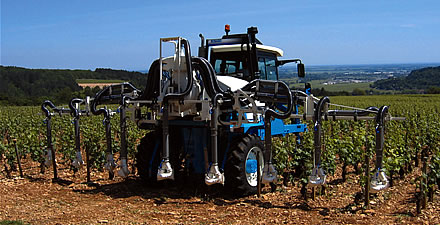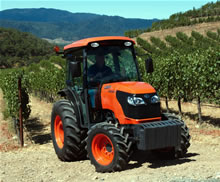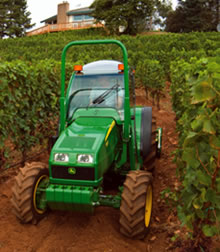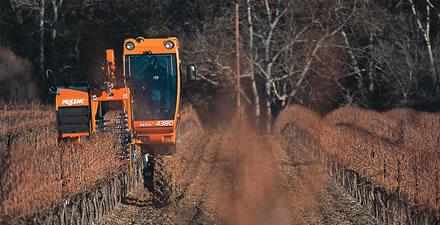
|
|
PRINT » |
|
|
E-MAIL THIS PAGE » |
|
|
CLOSE THIS WINDOW » |
Feature Article from the May 2008 Magazine Issue
Targeted Tractors
Conventional tractors give way to new, narrow, more specialized and multi-tasking machines

Several tractor makers will make major product introductions later this year, but they aren't willing to disclose details yet. In the meantime, enough has changed in recent years that an update on evolving features is timely. Ponder these assessments in between your spring mowing, disking and spraying.
As narrow as one meter
"All kinds of exciting new products are out there," says Garrett Buckland of Premiere Viticultural Services in Napa Valley.
"We've seen a real downsizing of tractors as row spacings have become tighter," Buckland notes, recalling that in the 1980s, spacings of 12 feet were common, and now 6 feet seems more the norm. Some rows now measure a mere meter wide.
As rows become narrower, growers are moving to narrower tractors--as narrow as 39 inches wide (1 meter)--or over-the-row tractors that straddle two rows. "Narrow is the wave of the future," says Pete Richmond of Silverado Farming, who manages 32 small, high-end Napa vineyards totaling 300 acres.
"As you get to 4-feet or meter spacing, you have to go to over the row," says Jerry Smith of Rainbow Tractor (rainbowag.com), a supplier in California's North Coast region. Most over-the-row models come from Italy or France, including Bobard, a supplier from Burgundy that Rainbow handles. Smith notes that many of the tractors are designed as mechanical harvesters, but that mechanism can be removed and other accessories can be added.
"The bigger outfits--or the ones with more money--go for over-the-row tractors," Buckland says. He says that his clients are smaller--he manages 2,000 acres--and they find that these sophisticated products are too expensive for their needs. About half of Smith's clients are wineries, and the others are independent growers and vineyard management companies.
Pete Richmond says he hesitates to go to over-the-row tractors because so few are used locally. "We get concerned about service."
As tractors get smaller, however, they're also getting less powerful. "The horsepower is going down, but that's not necessarily a bad thing," Buckland says. "They're more fuel efficient, and we're no longer cultivating vineyards the way we once did. We're doing less dirt work now. Many growers are going to no-till management, and we don't need big tractors pulling large disks."
Richmond agrees that there's plenty of horsepower for what he needs. His firm uses John Deere tractors for spacings of 6 feet or more, and it uses Landini and New Holland crawlers for fields with narrow spacing and on hills with slopes up to 35%. He just took over management of 25 acres with 4-foot spacing, and he says he is buying small tractors for that.

Buckland observes, too, that vineyards used to make do with tractors designed for orchards that were smaller than conventional tractors used for row crops, but they were still 7 feet wide. Now, 50-inch tractors are common, and some are even narrower. "The tractor manufacturers have seen that selling to the viticulture business can be very profitable, so they're developing more specific tools for this use," Buckland says.
He finds narrow Kubota 5400 and John Deere tractors are the most popular among his peers in California's North Coast, although larger tractors are popular in the sprawling vineyards of the Central Coast and Central Valley. "The North Coast is dominated by vineyard management companies, but the older areas see more large, independent growers." Buckland says it makes sense for a vineyard to have its own tractor if its growing area is more than 20 acres; below that, it probably makes more sense to depend on a management company.
Buckland says he's seen more viticulture-specific tools announced in the last decade, not only in the tractors themselves, but also in the implements--equipment like under-the-row tillers that independent suppliers are developing in partnership with the tractor makers.
Unfortunately, prices aren't coming down, even though the tractors are getting smaller. Part of the reason is that some of the tractors are exotic machines with expensive features like articulating bodies. "That's really overkill for most of our needs," Buckland says.
Rubber crawlers introduced
One innovation that has attracted attention is the rubber-tracked crawler introduced by Yanmar. "It's rather tall, but it's a good product for hillsides as it's very stable," Buckland says. The rubber tracks are also lighter than steel, and the crawlers don't compact soil the way wheeled tractors do, so they're better for wet fields. Some people question the durability of the rubber tracks, but Buckland says they last long enough in the relatively undemanding vineyard applications. They're also relatively slow, which can be an issue in some applications, but Buckland notes that wheeled tractors may not be safe on steep hills.
Clay Shannon, owner of Shannon Ridge Vineyards & Winery, manages vineyards sloping as steep as 35% in Lake County and uses the Yanmar crawlers. "My guys love them. They're safe and comfortable," he says. However, Shannon says the crawlers don't haul gondolas well at harvest. For that, Shannon sticks to Landini crawlers, which he says need a lot of maintenance.
"But they're good for dusting and spraying," he says. He finds that a lot of weight is desirable on the hills, and also uses John Deere tractors with wide gauge but narrow tires that weigh more than others.
One big innovation of the Yanmar crawler is that it is steered with a steering wheel just like a conventional tractor, not with levers like most crawlers, so it's easier for untrained and undedicated workers to use.
Growers also are showing an increased interest in biodiesel to fuel their tractors--to reduce dependence on petroleum and also to reduce emissions. Much of the fuel comes from refined soybean oil, but other growers use biodiesel derived from cooking oil that was either refined professionally or by themselves. In general, this only involves changing a filter. Richmond has looked at biodiesel, but he says he isn't using it now, partly because he has no storage area. "Our offices are in town, and we can't set up tanks and pumps there."
In like manner, some growers are buying electric ATVs, which are commonly used for handwork where tractors aren't appropriate. Barefoot Motors (barefootmotors.com) produces electric ATVs that it says can meet or exceed the performance characteristics of conventional products. It claims its Model One ATV provides high performance, heavy-duty speed and torque for agricultural applications, and a smoother ride with lower noise, less heat and zero fumes. It can tow 1,000 pounds.
The following are updates on individual tractor brands. Note that prices vary widely depending on power, configuration and accessories, and suppliers tend to stay competitive.
Bobard
Bobard (bobard.com) is a French company that produces over-the-row farming equipment increasingly popular with narrower vine row spacing. Its equipment was developed with Bordeaux vineyards that use close spacing, and, not surprisingly, also by Opus One in Napa Valley, which uses similar spacing. The tractor can be fitted with equipment for such operations as disking, cultivating, hedging, spraying and dusting, as well as mowing underneath vine rows. The tractor with a suite of appropriate implements is about $250,000.

John Deere (deere.com) was one of the first major American tractor suppliers to jump into the vineyard market. It introduced a line of Italian-made narrow tractors earlier this year. They're made by Deere's long-term partner, Goldoni Technology of Modena, Italy. Don Nipp of Lawrence Tractor Company in Visalia, Calif., says he's seen a lot of interest in the new small tractors from customers, but he is waiting for the first shipment next month.
The smallest model, 20A, is designed for nurseries and has a width of only 32 inches and a wheelbase of 39 inches. Powered by a 21 horsepower, two-cylinder Lombardini 954-cc diesel engine that complies with new Tier IV pollution standards, it incorporates an unusual articulated design that gives it a turning radius of only 4 feet. Its four wheels are equal in radius. It costs about $14,000.
The other three tractors are aimed squarely at the vineyard and related applications. The 2.7L VM Detroit Diesel engines provide 76 to 100 horsepower.
These tractors feature up to 24 forward gears, allowing them to deliver power while traveling at less than 1 mph to 20 mph. The three-point hitch has 5,500 pounds of lift capability and an adjustable rate control for lowering and raising the hub. The hydraulic system has a 10 gpm flow rate--powerful enough for usual implements.
The 76F tractor is 53 inches wide; the others are 57 inches and have a turning radius of 9.5 feet. All the tractors are low--the F series is 83 inches high to the rollover bar top. A cab is optional for the F models and includes air-conditioning and heating. The F series costs $36,000-$41,000.
Of course, Deere offers a full line of more conventional tractors, too. The most popular for vineyard applications, the 5000 family of narrow tractors, is priced from $27,000 to $47,000.
Kubota
Kubota tractors (kubota.com) are among the most popular for vineyard applications and are considered rugged and reliable. The company has a full line from yard tractors to general-purpose agricultural units. It will shortly introduce two additions to its M-series specialty tractors: the narrow cab M7040 and M8540. Designed to work in narrow applications, such as vineyards and orchards, they are versatile narrow-cab tractors with Bi-Speed Turn and the power of Kubota's M-Series. Equipped with 67 and 85 horsepower Kubota diesel engines, these tractors provide an exceptional work environment. Both models are 48 inches wide and 89 inches tall, with standard rear tires and maneuverability. The Kubota M7040F costs $23,300, and the M8540F costs about $26,000.
Landini
Landini (landini.com) offers the Rex Series of ultra-narrow vineyard specialty tractors as narrow as 39 inches. They're extensions of the Rex range, including six models from 67 to 81 engine horsepower with Perkins diesel engines. Available in both 2-wheel drive cab and 4-wheel drive cab versions, they feature a comfortable, easy-access cab, ergonomically loc ated controls, a variety of hydraulic options and a tilt-up hood. The Landini Rex vineyard tractors are about $44,000; its crawlers cost between $39,000 and $49,000.
Massey Ferguson
Massey Ferguson (masseyferguson.com), like a number of other traditional tractor suppliers, has targeted the vineyard market and will be introducing a Tier III engine and other changes this fall. At present, its vineyard series is the Tier II with Perkins diesel engines delivering 4-wheel drive at 64, 80, 90 or 98 engine horsepower. The V (vineyard) version is as narrow as 43.4 inches. A lower-powered, open tractor used for towing bins could cost as little as $22,000, while an 80-hp unit with enclosed cab for spraying could be $44,000.
New Holland
New Holland (newholland.com) will soon announce a major new line of tractors aimed at the vineyard market. For now, its offerings include the TNV-A vineyard tractor with a minimum overall width of 42.5 inches. A low center of gravity aids stability on hillside vineyards and slopes, and wheel rim diameters of 24 and 28 inches are available for both 2-wheel drive and 4-wheel drive models. A mid-mount, fold-down roll bar permits a height of 52.8 inches to the top of the steering dash to fit under low-hanging vines and trellises. The engines deliver up to 91 gross engine horsepower to power demanding applications such as sprayer and tillage applications in vineyards and orchards. The tractors include hydraulic power and a three-point hitch to help you work more efficiently and effectively. According to one dealer, the orchard version, the TNF-A, is actually more popular with grapegrowing customers. It is typically priced at $39,000 for the higher-powered tractor with 4-wheel drive and a cab.

Created in 1973, Pellenc S.A. (pellenc.com) is a leading manufacturer of mechanized equipment for the vineyard and orchard. Production facilities are in Europe, with sales and service centers in the United States. Pellenc offers a line of over-the-row tractors with minimum row widths of 4 to 7 feet that are capable of multitasks such as harvesting, pre-pruning, wire lifting, spraying and cultivating. The various over-the-row tractors are priced from $100,000 to $200,000. Pellenc America recently moved to a new, 10,000-square-foot facility in Santa Rosa, Calif. The new operation offers sales,
service and training on Pellenc's full line of tractors and other products.
Yanmar
Yanmar (yanmar.com) introduced its model T80 rubber-tracked crawler for vineyards in 2006 after five years of development. It was Yanmar's re-entry into the agricultural business in the U.S. under its own brand name. Yanmar's Kai Yasuda says the biggest advantage of the unit is that it doesn't compact soil. "It only creates 2.9 psi. It's also easy to drive in muddy conditions, especially in the winter, when growers need to spray."
You can also drive over paved roads with the rubber tracks--something not recommended for steel.
A big advantage is the wheel steering. "It drives like a big tractor, but it's the only one with wheel steering," Yasuda says. He adds that it doesn't have a front-loading attachment, but this is rarely needed in vineyards, and it does have the standard category II three-point hitch and gear-driven PTO. It has a 79-horsepower diesel engine and three spool hydraulic valves. The tractor is 52 or 65 inches wide depending on the width of the treads. The Yanmar T80 is priced in the $46,000-$56,000 range.
|
|
PRINT » |
|
|
E-MAIL THIS ARTICLE » |
|
|
CLOSE THIS WINDOW » |
